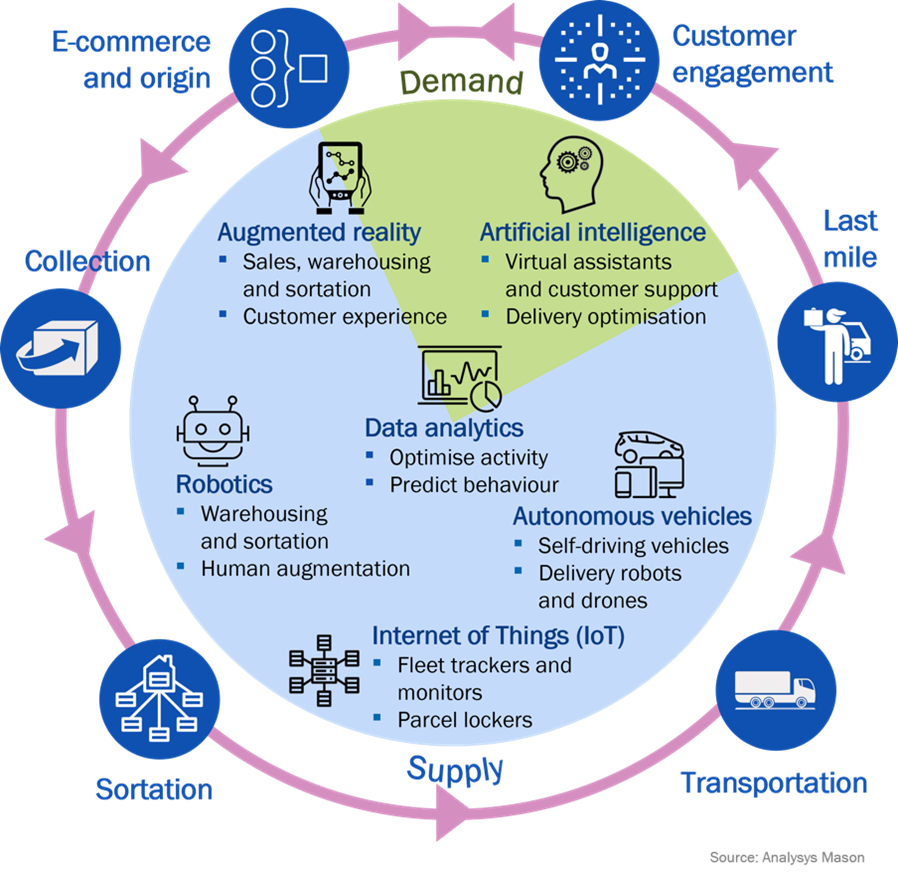“Distributed ledger technologies have the potential to shift the underlying co-ordination of the pipeline in the postal and parcel sector.”
New technologies are entering the pipeline in the postal and parcel sector worldwide. Some of these new technologies cover the demand side, where customers interact with the services, while other technologies are serving the logistics pipeline, such as robotics, IoT, and autonomous vehicles. All of these technologies are held in harmony by data and data analytics (see Figure 1).
Figure 1: New technologies embedded in the global postal and parcel pipeline

Several underlying technologies will not be apparent in the physical domain but will play an important role behind the scenes. These include the following three digital advanced technologies that show strong potential in the postal and parcel sector.
- 5G
- Private mobile networks
- Distributed ledger technologies (for example, blockchain)
Many countries worldwide now are licensing spectrum for 5G, which will offer low-latency, reliable communications to mobile networks, as well as support for massive machine networks (IoT). Private mobile networks are a recent development for mobile services, where a private network can be established that brings security and capacity guarantees to a private, closed user group. However, it can be costly to secure a private network due to the reserved network capacity. Distributed ledger technologies (DLTs), which are replacing the traditional in-house database, have important benefits but also have some specific drawbacks that are relevant for the global postal and parcel industry.
5G and private mobile networks may not be game-changing technologies for the postal and parcel sector on their own but DLTs have the potential to shift the underlying co-ordination of the pipeline
5G and private mobile networks may not be game-changing for the postal and parcel sector but can potentially serve as a network platform for new applications. Robotics, IoT and autonomous vehicles can be supported in different ways by 5G and potentially also by private mobile networks. Increasing adoption of these applications (particularly in advanced nations) will lead to transformation in the supply side of the industry.
Distributed ledger technology (such as blockchain) is important for many data-driven applications. It can be used in different segments of the postal and parcel industry, and has the potential to be game-changing for some areas of the sector, including certificates of goods origin, cross-border customs and handling and track-and-trace. However, some challenges must be overcome if a solution is to be implemented on a global or a national scale.
The adoption of DLTs presents both benefits and challenges for the postal and parcel sector
Benefits
Distributed ledger technologies offer an impressive list of benefits for serving the requirements of any database or data technology. In particular, the technology offers security and convenience, making it possible for people and objects to interact with each other within a transparent and decentralised database, unlike a centralised database that has to be managed. The distributed database provides details about what is happening to every party that is using the technology to run the business, or to run their part of the network, or to send/receive items. Distributed technology is resilient by design because it includes encryption and security features as standard. For example, its use in the finance sector demonstrates that it can significantly reduce the costs of running a global industry exchange by removing the high intermediary costs of international clearing gateways.
Challenges
There are some specific challenges that emerge when adopting distributed ledger technologies. The main challenge for the postal and parcel courier sector is the technology itself because it is a technical and data-intensive technology, and it must be adopted and implemented as a whole within that part of the ecosystem. This means that new distributed ledger technology cannot be easily mixed with old technology: it must be designed to be the digital database technology at the heart of the application.
Regulation is another important consideration. Public adoption is necessary: cryptocurrency is well-known but not well-understood or well-trusted, so the shift from traditional to distributed ledger technologies may be accompanied by mistrust and related challenges that will need to be overcome. Some businesses will embrace DLTs while others will have strong concerns. Furthermore, consumers and governments will need reassurance that critical national infrastructure such as postal and parcel delivery services are protected by well-developed regulations and security. There are also questions about energy consumption for computing power but further development of the ledger technologies should be able to solve this issue.
In order to implement distributed ledger technologies, the old digital database technologies that are hosted on equipment or in the cloud must be replaced with a new one that distributes the processing capacity used to run the DLTs. This means that organisations that are moving towards distributed technologies will reduce their own digital estate but replace this with work on the coding and development of applications and the actual technologies, which will then be released onto distributed processors.
There are already some good examples of DLT solutions that have been developed for postal and logistics purposes (for example, blockchain supports the use of crypto stamps and digital stamps). Crypto packaging and digitally enabled packaging are also being piloted to send items all over the world without the need for a central database; and such a system could work seamlessly on a global level.
A standalone business case, supported by a mature proof of concept, will be needed to demonstrate that these technologies can support new revenue-generating services, and/or lead to cost savings. A further challenge for the industry is that the implementation of DLTs will take significant time to reach global or regional critical mass through replacement of older technologies with more-efficient, digitally transformed, technology-driven solutions.
It is not yet clear whether 5G, private networks and DLTs will be fully successful in the context of the global postal and parcel sector.
El artículo original puede consultarse en:
